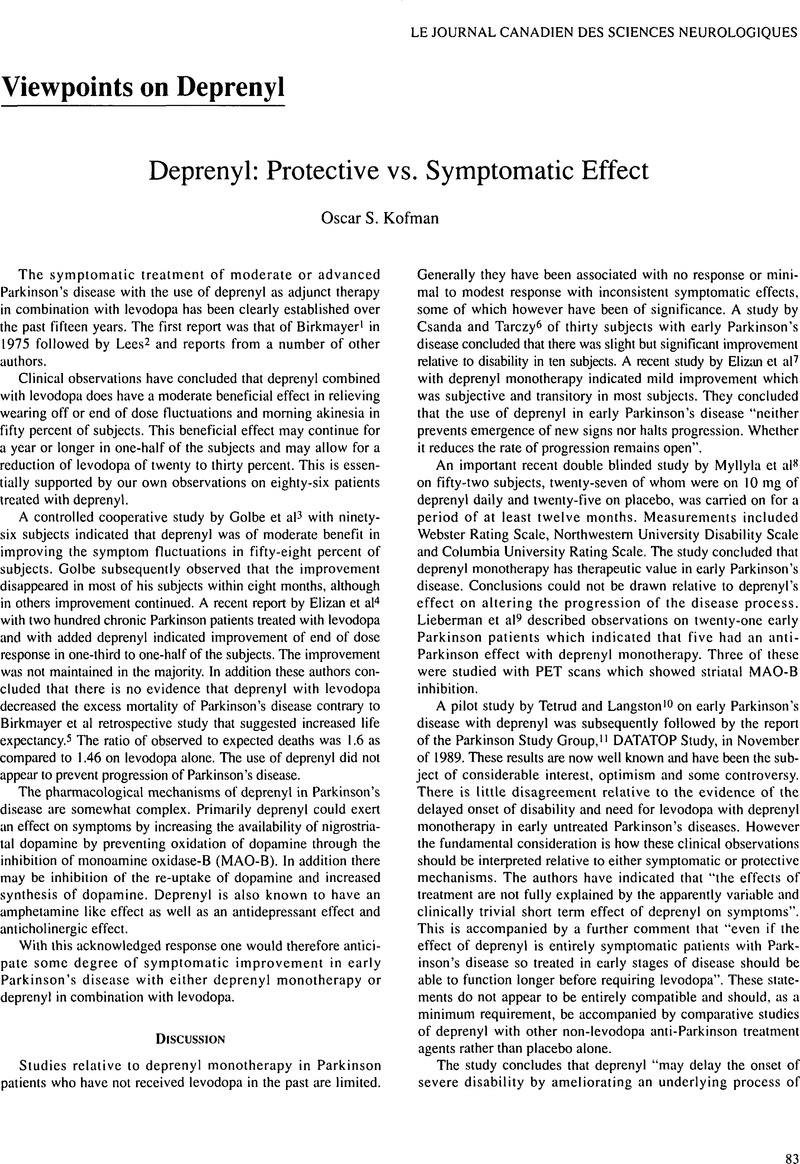Crossref Citations
This article has been cited by the following publications. This list is generated based on data provided by Crossref.
Vezina, Paul
Mohr, Erich
and
Grimes, David
1992.
Deprenyl in Parkinson’s Disease: Mechanisms, Neuroprotective Effect, Indications and Adverse Effects.
Canadian Journal of Neurological Sciences / Journal Canadien des Sciences Neurologiques,
Vol. 19,
Issue. S1,
p.
142.
Schneider, J. S.
Pope, A.
Simpson, K.
Taggart, J.
Smith, M. G.
and
DiStefano, L.
1992.
Recovery from Experimental Parkinsonism in Primates with GM
1
Ganglioside Treatment
.
Science,
Vol. 256,
Issue. 5058,
p.
843.
Calne, Donald B.
1992.
The free radical hypothesis in idiopathic parkinsonism: Evidence against it.
Annals of Neurology,
Vol. 32,
Issue. 6,
p.
799.
1993.
Protective Effect or Symptomatic Effect of Deprenyl?.
New England Journal of Medicine,
Vol. 328,
Issue. 23,
p.
1715.
Rinne, J. O.
1993.
Nigral degeneration in parkinson's disease.
Movement Disorders,
Vol. 8,
Issue. S1,
p.
S31.
Fowler, Joanna S.
Volkow, Nora D.
and
Wolf, Alfred P.
1993.
Nuclear Imaging in Drug Discovery, Development, and Approval.
p.
179.
Barthalmus, George T.
Hardin, Laura K.
and
Thompson, David
1993.
MAO-A and -B inhibitors selectivity alter Xenopus mucus-induced behaviors of snakes.
Pharmacology Biochemistry and Behavior,
Vol. 44,
Issue. 2,
p.
321.
Yu, Peter H.
1994.
Pharmacological and clinical implications of MAO-B inhibitors.
General Pharmacology: The Vascular System,
Vol. 25,
Issue. 8,
p.
1527.
Dingemanse, Jasper
Wood, Nolan
Jorga, Karin
and
Kettler, Rolf
1997.
Pharmacokinetics and pharmacodynamics of single and multiple doses of the MAO-6 inhibitor lazabemide in healthy subjects.
British Journal of Clinical Pharmacology,
Vol. 43,
Issue. 1,
p.
41.
Dingemanse, Jasper
Wood, Nolan
Jorga, Karin
and
Kettler, Rolf
1997.
Pharmacokinetics and pharmacodynamics of single and multiple doses of the MAO‐6 inhibitor lazabemide in healthy subjects.
British Journal of Clinical Pharmacology,
Vol. 43,
Issue. 1,
p.
41.
Doudet, Doris J
Chan, Grace L.Y
Holden, James E
Pate, Brian D
Morrison, K.Scott
Calne, Donald B
and
Ruth, Thomas J
1997.
Effects of monoamine oxidase and catechol-O-methyltransferase inhibition on dopamine turnover: A PET study with 6-[]l-DOPA.
European Journal of Pharmacology,
Vol. 334,
Issue. 1,
p.
31.
Rothblat, David S
and
Schneider, J.S
1998.
The effects of l-deprenyl treatment, alone and combined with GM1 ganglioside, on striatal dopamine content and substantia nigra pars compacta neurons.
Brain Research,
Vol. 779,
Issue. 1-2,
p.
226.
Blunt, S. B.
2001.
Clinical Trials in Neurology.
p.
311.





